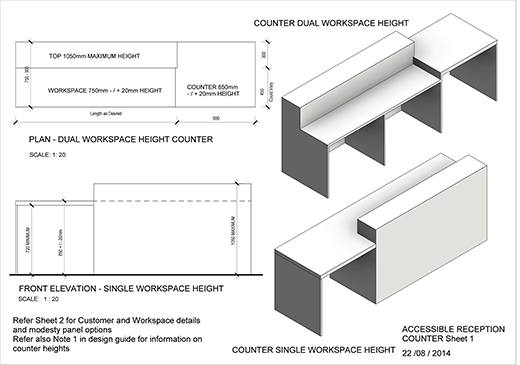The access provisions of Premises Standards 2010 have been incorporated into NCC Volume 1 BCA, effective from 1 May 2011.
In all public buildings, access is required to and within all areas normally used by the occupants. Fit-out criteria for these spaces are not included in the BCA. Uninformed design of fit-out can render a space inaccessible, despite its compliance with the BCA access provisions . Inaccessible buildings and spaces are at risk to complaint under the DDAct.
Accessible reception counter
1. APPLICATION
Reception counters are a key facility for many businesses including offices, information centres, hotel and tourist industry, retail counters etc. Accessibility design considers both the customers and workplace sides.
2. DESIGN CONSIDERATIONS
This Design Guide contains criteria for elements which are beyond the scope of the NCC and the Premises Standards. As far as possible it does not repeat the mandatory requirements of the NCC.
A reception counter has a customer side and a workplace side. This note treats each as a discrete component. It is not necessary that they face each other, although the illustration shows that arrangement. AS1428.2 anticipates front-on approach from the customer side, but this imposes severe restraints on reach for both customer and staff and is not recommended.
Placement
Locate the accessible customer side component in conspicuous position, easily found from the point of entry. It may require a tactile path to it or a raised tactile/map near the entry, which also defines the layout of the area and how to find the counter.
Circulation
Minimum depth of clear circulation space each side of counter - 1500mm.
Counter height
- Maximum counter height - 1050mm
Customer side counter
- Width - 850mm minimum
- Height - 850mm ± 20mm (see note 1)
- Depth above counter - 300mm minimum, 475mm maximum
Minimum depth below counter: This is determined by the presence or absence of a modesty panel and whether or not this extends to the floor (see illustrations). The space below the counter should allow knee/toe clearance as shown in AS1428.1 Figure 45.
A recess in the face of the modesty panel 300mm high above the floor and 200mm deep, or a clearance under the panel for 300mm allows the customer to access a greater counter depth.
Workplace
- Width - 850mm minimum
- Height - 750mm ± 20mm (see Note 1)
- Depth above counter - 600mm maximum
- Depth below desk - provide knee/toe clearance to AS1428.1 Figure 45
- Width below desk - 850mm minimum
Adjustability
See Note 1.
Controls
Locate controls within 300mm from the front of the counter (for customers) or desk (for workers), maximum 1350mm high for side reach and maximum 1120mm high for forward reach, minimum 500mm from any internal corner.
Other features
Consider provision of a sound augmentation system to assist communication with a person with a hearing impairment where the customer is not screened from the service provider. Provision is mandatory when screening is present. Avoid screening wherever possible.
Provide glare free illumination of minimum 450 lux over counter top
Ensure the finish of counter and desk is not highly reflective.
Face-to-face arrangement
See AS1428.2-1992 Figure 20(b) which illustrates the maximum forward reach over an obstruction. If receptionist and customer/desk are to exchange documents there must be a zone which both may reach. An overall counter depth of 900mm will provide a zone of 200mm with the knee/toe clearance of AS1428.1 Figure 45 provided the modesty panel, if any is provided, is a maximum of 20mm thick and centrally located.
Flexibility of accessibility is improved if there is no modesty panel and the station is 1200mm wide especially if the accessible counter is only 300mm deep as the wider space enables the wheelchair user to approach at an oblique angle.
3. REFERENCES
AS1428.1 – 2009 (Incorporating amendment No. 1 - 2010)
Design for Access and Mobility Part 1: General Requirements for Access—New Building Work
AS1428.2 – 1992
Design for Access and Mobility Part 2: Enhanced and Additional Requirements—Buildings and Facilities.
4. DRAWINGS
Accessible reception counter
Note: 1 No individual table, counter or work top height and clearance under will suit all users with disabilities. A bench with easily adjustable height within the range of 700mm to 900 mm from the finished floor is preferred. For occasional use such as a customer counter, support facilities and the like the height should be 850mm±20mm. For workplace use such as desks, if a fixed height is provided the height should be 750mm±20mm. If a stool is available then a height of 850mm±20mm is acceptable for ambulant staff. If more than one facility is provided then the above should apply to the first and other dimension can apply to subsequent facilities.
Disclaimer
This content is provided by the Australian Institute of Architects for reference purposes and as general guidance. It does not take into account specific circumstances and should not be relied on in that way. It is not legal, financial, insurance, or other advice and you should seek independent verification or advice before relying on this content in circumstances where loss or damage may result. The Institute endeavours to publish content that is accurate at the time it is published, but does not accept responsibility for content that may or has become inaccurate over time. Using this website and content is subject to the Acumen User Licence.

